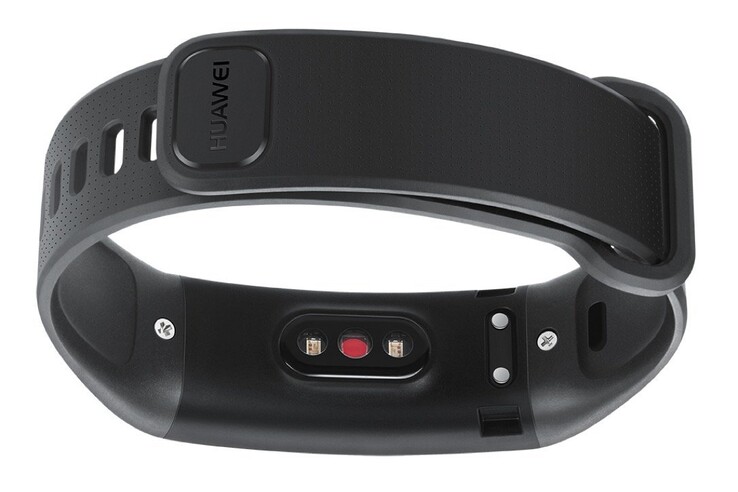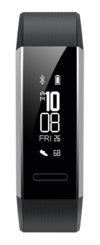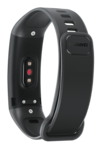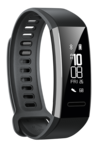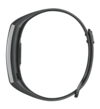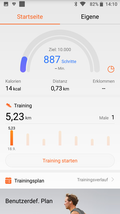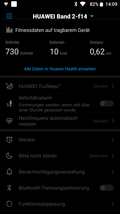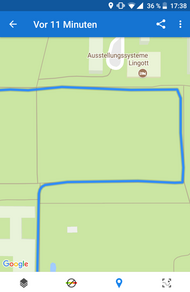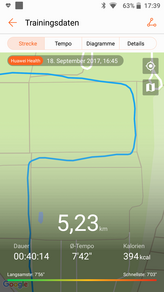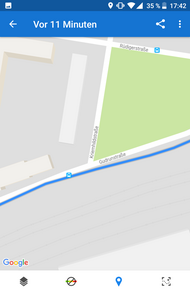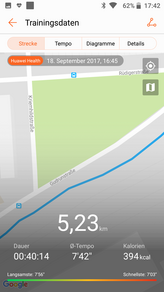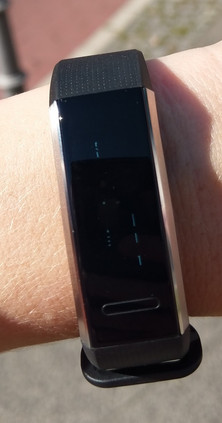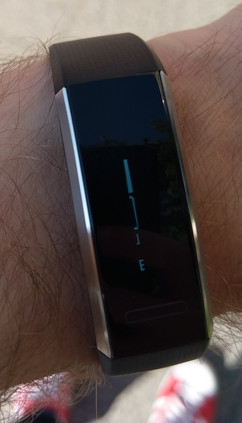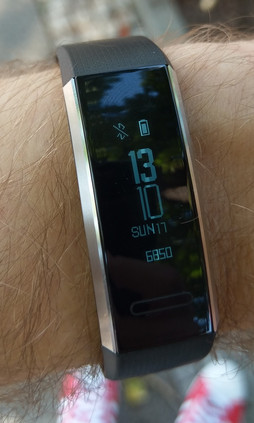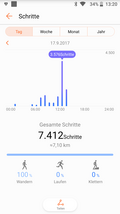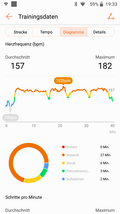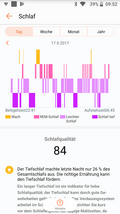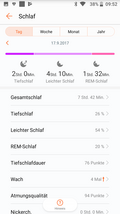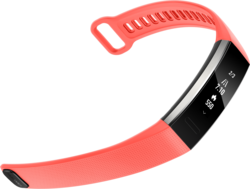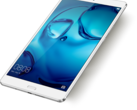Huawei Band 2 Pro Smartband Review
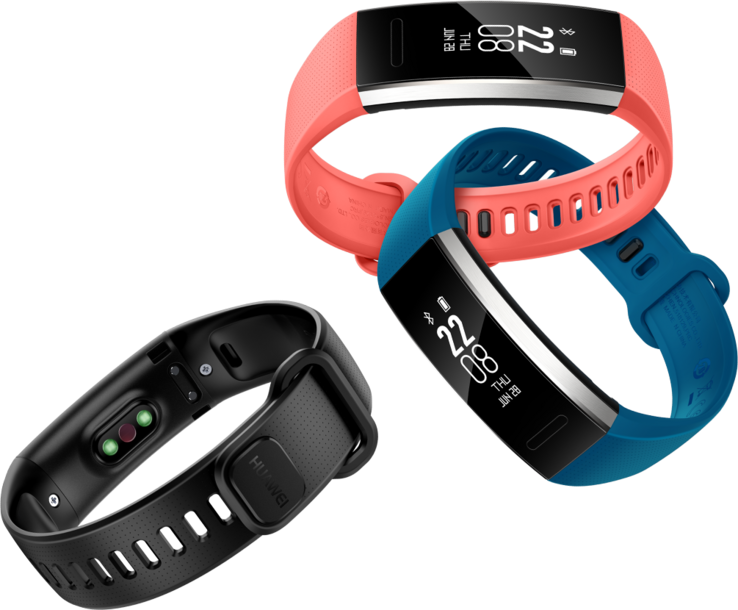
For the original German review, see here.
The newest fitness tracker by the Chinese manufacturer Huawei comes with a multi-sport tracking function for walking, running, swimming, and cycling. A combination of infrared sensors, three-axis accelerometer, and heart-rate monitor is supposed to provide optimal tracking of the heart rate and blood oxygen level, as well as analyze the sleep behavior of the user. In addition, it will record routes with the built-in GPS tracker.
The collected information can be read directly on the Huawei Band 2 Pro. For this, the fitness tracker is equipped with a monochrome 0.91-inch PMOLED display. The performance of the wearable is driven by a non-specified processor with a Cortex-M4 architecture. According to the manufacturer, the 100-mAh battery in the Huawei Band 2 Pro is supposed to last for about 21 days of average usage.
The Huawei fitness tracker is offered in black for a recommended price of almost 100 Euros (~$119) in the German market (and ~$70 in the US with a black, red, or blue color band), but at this point it is available for 10 Euros (~$11) less on the street. This is a high price if you consider that the Xiaomi Mi Band 2 is available for about 15 Euros (~$18) as an import. However that does not have a GPS module.
Case
The case of the Band 2 Pro is protected against dust and water up to 5 ATM, so you can take the Huawei fitness band into the shower or the pool with you without any concerns. At a weight of only 21 grams, you hardly notice wearing it after a while.
Similar to the Xiaomi Mi Band 2, the Huawei Band 2 Pro also has two components: a display unit with a stainless steel frame and a plastic wristband made from thermoplastic polyurethane. However, here it is fixed to the display unit with two screws. The plastic of the wristband is very flexible and wearing it feels comfortable. The desired length can be adjusted in 14 steps, so that you should be able to adjust it for wrists of any size.
Part of the glass front is filled with an OLED panel with a diagonal of a little less than 2.5 cm (0.91-in). Relative to the size of the display unit, the actual display is quite small. We measure a value of about 20%. The manufacturer does not specify the exact material of the glass surface. Below the OLED panel is a touch-sensitive control element, a flat rectangle set flush into the case.
On the bottom of the display unit are the sensors, the GPS module, and a contact surface for the charging station that charges the Huawei Band 2 Pro via a USB cable.
Features
The Huawei fitness wristband has a vibration module and an OLED display for visual display of smartphone notifications. If there is a Bluetooth connection to the smartphone, calling, WhatsApp, SMS, and app notifications or downloads are sent to the tracker via the so-called Smart Assistant. A wake function through vibration is also integrated into the Huawei Band 2 Pro.
Software
Huawei specifies the operating system for the Band 2 Pro as an RTOS (real-time operating system), which is able to process requests from the apps in real-time. The fitness tracker is compatible with mobile Android and Apple devices starting from Android 4.4 and iOS 8.0, respectively.
Besides the actual Huawei Wear app which is necessary for the setup, there are also other applications necessary for optimal usage of the Huawei fitness wristband, such as the Huawei Mobile Services or the Huawei Health app. All the necessary apps are available for free in the respective app stores.
Communication and GPS
The Huawei Band 2 Pro connects to the smartphone via Bluetooth. The Chinese manufacturer does not specify the exact version, though. There are no other connections in the fitness tracker. The connection was not always stable during the period of our testing. The Huawei Band 2 Pro often shows a missing connection and we had to close and restart the apps for the fitness tracker to be recognized again.
We examined the GPS accuracy on an about 5 km (~3.1 miles) long running route, comparing it with the GPS module of the Google Nexus 5X which convinced us in the GPS test. In terms of its accuracy, the Huawei Band 2 Pro was not really able to score in comparison to the Google smartphone with its RunTastic app. Often the traced route was very inaccurate and the overall length measured was considerably longer than that of the Google Nexus 5X (5.08 km overall).
Accessories and Warranty
Besides a charging station and charging cable, there is a quick-start guide, safety information, and a warranty card in the box. There is no separate power supply for the fitness tracker.
According to the included warranty card, Huawei offers a 24-month warranty on the Huawei Band 2 Pro. Please see our Guarantees, Return Policies & Warranties FAQ for country-specific information.
Input Devices and Operation
The Huawei fitness wristband is operated via the touch-sensitive sensor below the display. Upon a short touch of the touch-sensitive area, the display of the Huawei Band 2 Pro shows the time, date, and amount of steps as well as the Bluetooth connection and battery level. By repeating this input, you can set and display further analysis data, such as the amount of steps, pulse rate, or various activity modes (running, swimming, bicycling). The user can configure in the Huawei Wear app, which data to show on the display.
There is an optional setting in the Huawei app to activate the display by raising the arm. You can also switch between the various analysis data displays by purposeful turning of your wrist.
Display
The POLED display of the Huawei Band 2 Pro has a diagonal of a little less than 2.5 cm (0.91-in). Looking closely, you can easily recognize the separate pixels, but this is not very disturbing when using the monochrome panel. At the time of the test, we were unable to find out the exact resolution (PPI) of the display.
In bright surroundings, the maximum brightness of the panel was unconvincing. In direct sun, you need to shade the fitness wristband with one hand to still be able to recognize anything. But even then you could not always read what was on the display.
Like in the Xiaomi Mi Band 2, the display of the Huawei Band 2 Pro shows PWM flickering to adjust the brightness in the test (see picture). This means that the illumination of the display is quickly turned on and off periodically to adjust the brightness of the display. However, considering the short time you look at a fitness tracker display, this type of brightness regulation should not become a problem even for PWM-sensitive people.
Functions
For its fitness tracker, Huawei offers various functions and modes to analyze various sports. You can also create your own training plans and evaluate them with an algorithm for running.
The PPG heart rate monitor measures the heart-rate either manually or continuously. Various measuring intervals are available if you activate automatic heart-rate monitoring. In "Daily" mode, the heart rate is measured every 30 minutes, and in the "Sport" mode, the PPG heart-rate monitor becomes active every second. In addition, after each activity the Huawei Band 2 Pro determines the VO2 max values, which measure your endurance, via infrared and heart-rate sensors.
Besides activities, the Huawei Band 2 Pro can also analyze the sleep patterns of the user and evaluate sleeping habits. Based on this, the TruSleep sleep-monitoring offers information and hints to improve the sleep quality. In the test, sleep and also short waking times were recognized well, indicating that the resulting data appears to be fairly reliable. If you want to be woken by the Huawei Band 2 Pro in the morning, you can either specify a fixed wake time or an "intelligent alarm," which starts with gentle vibrations up to 30 minutes before the actual planned wake time.
Battery Life
According to Huawei, the power supplied by the 100-mAh battery should be sufficient for a standby time of up to 21 days. If you use all the functions of the fitness tracker such as sleep-monitoring and constant heart-rate monitoring, the battery life is lowered considerably. In GPS mode there is only a runtime of 3.5 hours, according to the manufacturer.
Having a constant Bluetooth connection with the smartphone reduced the battery level of our test unit by about 10% per day. During our test period, we used the "Daily" mode for the heart rate and the TruSleep sleep-monitoring every day. In addition, we used the Band 2 Pro for the daily recording of the steps and app notifications. During a run lasting about an hour with GPS location and the constant heart-rate monitoring in the "Sport" mode, the Huawei Band 2 Pro uses about 30% of the battery capacity in the test.
It takes about 1.5 hours to charge the Huawei fitness tracker.
Pros
Cons
Verdict
The Huawei Band 2 Pro does its job: it reliably records the activities of the user, and in our opinion its measurements are plausible. Their evaluation via Huawei's in-house apps is detailed and described in an easily understandable way, at least in the Android operating system we tested.
There is nothing to complain about in the workmanship of the wristband and display unit. However, we feel that the size of the display is a little too small considering the wide size of the surrounding display frame. The maximum brightness is also insufficient during sunny weather, which really should not be the case in a fitness tracker that costs 100 Euros (~$119). In light of the OLED technology used, we would have liked a kind of always-on function and a brightness regulation feature for the display, since it is definitely too bright at night. We also find the locating of our position with the GPS module of the fitness tracker slightly too imprecise.
For ambitious amateur runners, the Huawei Band 2 Pro is a neat fitness gadget, even if we see room for improvement in some places.
Anyone who can live without the GPS location and reliable heart-rate monitoring should take a look at the Xiaomi Mi Band 2. The low-budget fitness tracker is available for about 15 Euros (~$18) from various import companies and also offers sleep-monitoring as well as a heart-rate monitor (even if it is not always reliable).




